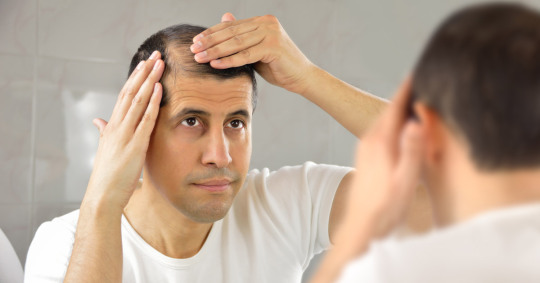#hairfalltreatmentinRajouriGarden
Text
Hair Loss: Diagnosis & Therapy

Full head hair is generally considered a beauty ideal. The self-confidence of many affected people suffers, even more, when there is increased hair loss. The possible causes for this range from genetic predisposition to pregnancy to various diseases. There are different forms of hair loss that have different causes. The respective treatment also depends on the trigger, says dermatologist in Delhi.
Life cycle of hair
Normally, humans have around 80,000 to 100,000 hairs on the head - blondes somewhat more, redheads less. There are around a million sac-shaped hair follicles on the head, which are only a few millimeters in size. About every tenth of these hair roots is currently active and forms new hair. The life cycle of the hair is divided into three sections:
Growth phase: 80 to 90 percent of the hair is in this phase. It takes about two to six years on average and determines the maximum hair length. Hair grows about an inch a month. People with a rather short hair growth phase can therefore not get very long hair, even if they have it cut rarely and little.
Transitional phase: This section is short.
Rest phase: After this period of about two to four months, the hair falls out on its own. We usually lose about 50 to 60 hairs a day, with a hair wash it can be up to 100 hairs.
If more hair falls out, this life cycle is disturbed and the cause should be clarified by a dermatologist in Vishnu Garden. Depending on the trigger, various options for hair fall treatment in Rajouri Garden are available.
How is the diagnosis of hair loss made?
In consultation with the person affected, the dermatologist in Rajouri Garden clarifies whether there is a family history of hair loss or a one-sided diet. In addition to a connection with possible causes (is eg infections, metabolic disorders or hair-damaging influences) wanted. This is followed by a physical examination, especially of the scalp, and, if necessary, a microscopic examination of the hair root and skin samples. Blood tests may also be necessary.
Forms, causes, and therapy of hair loss
There are different forms of hair loss that have different causes. The respective treatment also depends on the trigger. The options range from various local therapies to systemic therapies and so-called mesotherapy. Low-dose substances are injected directly into the scalp, explains skin specialist in Rajouri Garden.
If these treatments are not or not sufficiently effective and the suffering is high a wig, a toupee or hair plaits can help. Hair transplant in Delhi should be used with caution and should only be performed by specialized professionals, as it can lead to complications such as rejection and chronic infections.

Conditioned hair loss
Causes: This genetic and hormonal form (androgenetic alopecia) is responsible for hair loss in around 95 percent of cases - both in women and, even more frequently, in men. Increased sensitivity of the hair root to male hormones (androgens) reduces the size of the hair follicles. Hair production is restricted and hair also falls out faster. In men, there is increased beard growth. An increase in the sebum glands on the head also contributes to the loss of scalp hair, says skin specialist in Vishnu Garden.
Symptoms: Hair loss often begins at puberty. In the middle years of life about every second man is affected. Frequently, "receding hairline corners" appear, which develop into partial or full baldness over time.
In women, the entire scalp thins out. At the same time, unpleasantly increased hair develops on other parts of the body, for example on the legs, lower legs, toes or on the face.
Therapy: There are no preventive measures for this form, the effect of which has been scientifically proven. Medications are available for treatment that can stop hair loss. In areas that are already bald, hair no longer grows back, because the hair roots have already shrunk and this can no longer be reversed. Different preparations are sometimes used for women and men. Most of the time, permanent use is required, suggests dermatologist in Tagore Garden.
Treatment in men: The active ingredient finasteride affects testosterone metabolism. It must be taken regularly and over a long period of time. Potency problems are a possible side effect.
Treatment in women: Combined hormone preparations ( estrogen and progestogen ) - eg the birth control pill in younger women - act as an antagonist to testosterone. Solutions containing estrogen can be applied locally to the scalp. These only work during the period in which they are used. Women - especially during pregnancy - should not use finasteride.
Treatment in women and men: The active ingredient minoxidil must be dosed lower in women than in men. It is applied locally to the scalp. The mode of action has not yet been fully clarified. Minoxidil may expand the blood capillaries due to its hypotensive effects and thereby promote blood circulation. In addition, it seems to shorten the resting phase of the hair cycle.
Circular hair loss
Causes: The triggers of the so-called alopecia areata are not exactly known, autoimmunological factors are discussed. The body's own defense cells attack the hair roots. The frequent occurrence within a family also suggests a genetic predisposition. Adolescents are affected relatively often (around one in 1,000). The psychological suffering is particularly high at this age. Stress seems to be an important trigger factor for this presumably autoimmune-related illness, says skin specialist in Tagore Garden.
Symptoms: The main characteristic is sudden circular hairless spots on the head. Since pigmented hair is mainly affected, those affected often turn gray in a relatively short time. The entire body hair can rarely fail (Alopecia Universalis). The hair can grow back spontaneously after a few months, but can then be lost again.
Therapy: Since the causes are mostly unknown, the treatment is difficult and is often little or only temporarily effective. In some cases, spontaneous healing occurs. Inflammation at the roots of the hair is attempted to be relieved by various local measures, as explained by dermatologist in Subhash Nagar:
circulation-promoting tinctures, minoxidil,
anti-inflammatory drugs,
local application of diphencypron (DPCP) or squaric acid,
Irradiation with UV light,
oral zinc administration.
Scarring hair loss
Causes: Inflammation of the scalp leads to irreversible hair loss with scarring. The following factors are possible triggers:
Physical damage: eg X-rays, burns, burns;
Deep infections: mostly with bacteria or fungi, less often with viruses;
Autoimmune diseases: eg lupus erythematosus or morphea;
Unclear cause (idiopathic): chronic, purulent, deep folliculitis (folliculitis decalvans).
Symptoms: Perifollicular inflammation and excessive cornification of the skin (hyperkeratosis) can be found in the area of the hair on the head. Mostly, scars can be seen on the scalp between the inflamed areas.
Therapy: If possible, a causal - ie mostly effective against bacteria or fungi - treatment is carried out. Depending on the severity, glucocorticoids, retinoids or immunosuppressants can also be used, says skin specialist in Subhash Nagar.
Diffuse hair loss
Causes: Above all, diseases, lack of nutrients or external damaging influences on the hair itself are the triggers, among others :
After birth or after puberty;
Infections: eg shingles, erysipelas ;
Metabolic disorders: eg diabetes, increased blood lipids, diseases of the liver or thyroid, disorders of the sex hormones;
Deficiency symptoms, eg through one-sided diets ( especially undersupply with iron, zinc, folic acid, vitamin B12 );
Hair-toxic substances: environmental pollutants, medication
Hair-damaging influences: e.g. frequent wearing of headgear, intensive combing, and brushing, rubbing, tight hair bands, tinting, dyeing, bleaching, perming, frequent washing with alkaline shampoos, hot blow-drying, intensive sun exposure.
In addition, diffuse hair loss can also occur with chronic stress, after birth or puberty, seasonally or as a normal age-related process explains dermatologist in Shastri Nagar.
Symptoms: The head hair thins more and more overall. If the cause is remedied, the hair can grow back as long as the hair roots are still intact.
Therapy: treatment or elimination of the cause.
Whom can I ask?
In the event of sudden or prolonged hair loss, you can contact the following:
General practitioner,
Specialist in dermatology and venereology.
It is advantageous if the skin specialist in Shastri Nagar has special training and sufficient experience in the treatment of hair loss. Discuss the possible therapy options, their potential chances of success and the associated costs in advance.
Read the full article
#dermatologistinDelhi#dermatologistinRajouriGarden#hairfalltreatmentinRajouriGarden#HairLoss#health#skinspecialistinRajouriGarden
0 notes